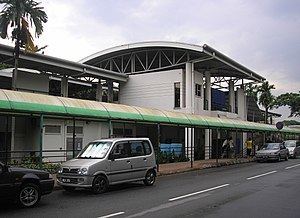Parking None Opened 16 December 1996 | Station code AG2 Tracks 2 | |
 | ||
Similar Maluri LRT station, Chan Sow Lin LRT station, Pudu LRT station, Pandan Jaya LRT station, Hang Tuah station | ||
Miharja LRT station is a Malaysian at-grade rapid transit station situated near and named after Taman Miharja (Malay; English: Miharja Estate). The station is part of the Ampang-bound branch of the Ampang Line (formerly known as STAR-LINE)
Contents
- Map of Lrt Station Miharja Taman Miharja 55200 Kuala Lumpur Wilayah Persekutuan Kuala Lumpur Malaysia
- Location
- Design
- References
Map of Lrt Station Miharja, Taman Miharja, 55200 Kuala Lumpur, Wilayah Persekutuan Kuala Lumpur, Malaysia
The station was opened on December 16, 1996, as part of the first phase of the STAR system's opening, alongside 13 adjoining stations along the Sultan Ismail-Ampang route.
Location
The Miharja station is situated at the southwestern side of the Miharja Flats, a complex of flats close to Kerayong River in the locality of Taman Miharja, off Jalan Loke Yew (Loke Yew Road). The station directly serves the aforementioned flats, as well as the remaining portion of Taman Miharja and the Ue3 shopping centre from the opposite side of Jalan Loke Yew, which also have similarly close access to Maluri station.
The Miharja station was constructed along two leveled tracks, reusing the now defunct Federated Malay States Railway and Malayan Railway route between Kuala Lumpur, Ampang and Salak South. The station is also the last station from the Ampang terminal before a convergence with the Sri Petaling-bound line and the Chan Sow Lin interchange, 850 metres northward.
Design
Overall, the Miharja station was built as a low-rise station along two tracks for trains traveling in opposite direction. Because the station is nearly at-grade and features two side platforms, the station designates individual ticketing areas for each of the station's two platforms at their level, ensuring access to trains traveling the opposite direction is not freely possible.
The principal styling of the station is similar to most other stations in the line, featuring curved roofs supported by latticed frames, and white plastered walls and pillars. Because stairways are only used to link street level with the station's ticket areas and platforms, the station is not accommodative to disabled users.
